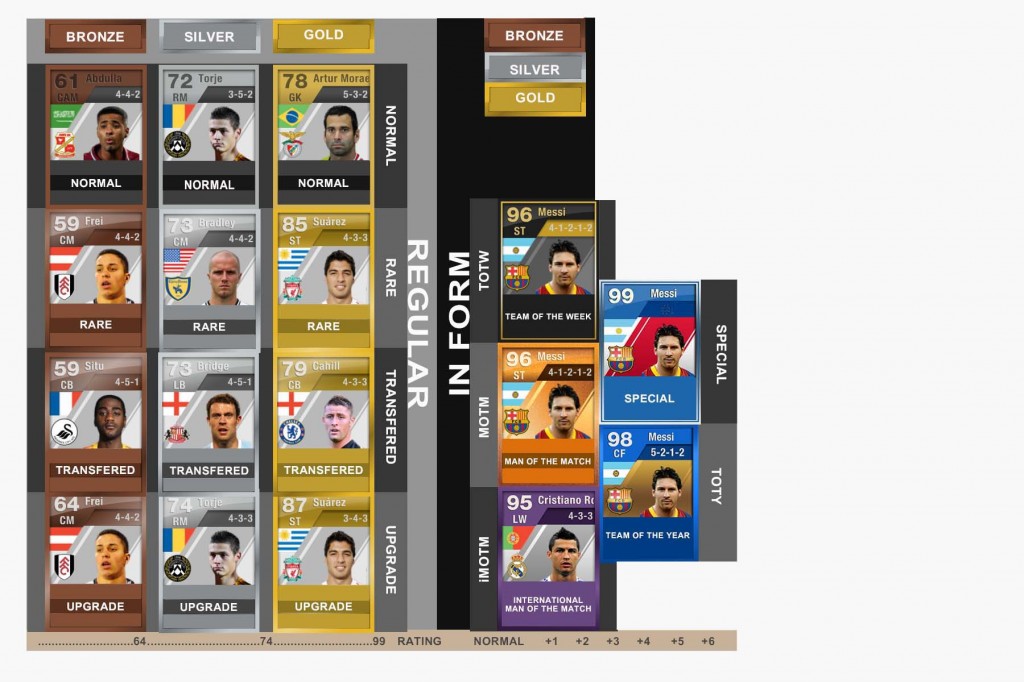For those who do not have much practice in FIFA Ultimate Team, one of the biggest problems they may face is to understand why there are so many different cards.
In some cases, a single player might have several cards.
In this article, we explain what types of FIFA Ultimate Team Players’ Cards you can find.
The Release of FIFA Ultimate Team Players’ Cards
One of the first things you should try to answer is “where come from the cards?”.
The FIFA Ultimate Team Players’ Cards are created by the game system that places them in transit by three methods:
- assignment when registering a new team;
- assignment when purchasing packages in the store;
- assignment when winning tournaments whose prizes are packages.
FIFA Ultimate Team Players’ Cards Levels
Depending on player’s quality, the cards can be of one of the following three categories:
- Bronze, for ratings up to 64;
- Silver, for ratings between 65 and 74;
- Gold, for ratings between 75 and 99.
Whether it is a regular card or an in form card, all players fit in one of these three levels.
Regular FIFA Ultimate Team Players’ Cards
At the launch of the game, all the FIFA Ultimate Team Players’ Cards assigned belong to the Regular category. These cards have the innate characteristics and attributes of the player.
When a particular card is released for the first time and assigned to its first owner, the physical condition and mental state are high (99 of fitness and 80 of moral) and are registered seven contracts.
As the game progresses, users can change many of the card features such as the preferred position and preferred tactical scheme. However, these cards are still considered regular cards. Only the game system can create not -regular cards, called In Form cards.
Rare FIFA Ultimate Team Players’ Cards
Within the category of regular cards there is a variant which is distinguished by its bright and luminous aspect. Are called Rare Cards. These cards meet the need that EA had to make some cards more common than others. Does not necessarily mean that they are most valuable cards.
A player can not have associated with him a regular rare card and a regular not-rare card.
Upgrade/Downgrade FIFA Ultimate Team Players’ Cards
Although unusual, the EA Sports team releases in January FIFA Ultimate Team Players’ Cards to adjust the rating assigned to them.
This type of situation occurs when the players in the real world had a very strong positive or negative trends, making misfit the value assigned to them in Ultimate Team.
Physically, these cards are identical to the originals.
FIFA Ultimate Team Players’ Transfer Cards
In real world, when a player moves from his club to another, EA Sports launches new cards of this players with the name of his new club and eventually his new league. This is the only difference you’ll find between the new card and his previous card.In January transfers, ratings and technical attributes remain unchanged. If the card has been released due to a transfer of the end of season, these values can be changed.
The most interesting thing about these cards is related to the fact that they can benefit your team chemistry because they allow new pairings of clubs, leagues and nationalities with teammates.
From the time that the new cards are released, will not be issued cards with the previous club.
In Form (IF) FIFA Ultimate Team Players’ Cards
One of the features that makes the game mode FIFA Ultimate Team so interesting is its dynamic component. During the season, and depending on the players’ form in the real world, EA releases In Form (IF) Cards that change the players’ attributes. By becoming owners of one of these cards, we are buying a player with his attributes improved.
IF Cards are the most valuable cards of FIFA Ultimate Team and can be grouped into the following categories: TOTW (Team of the Week), MOTM (Man of the Match), iMOTM (International Man of the Match), TOTY (Team of the Year) or Special.
To learn more about In Form Cards, read our article about this subject.
FIFA Ultimate Team Players’ Cards Summary
Basically there are two types of FIFA Ultimate Team Players’ Cards: Regular Cards, which can be normal, rare, upgrade / downgrade or transfer; and the In Form Cards.
For being a slightly complex issue, it can raise some questions. So, we developed a example scheme that clarifies what different types of FIFA Ultimate Team Players’ Cards exist.

